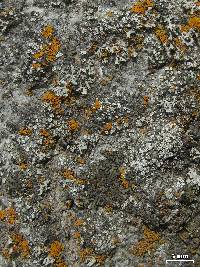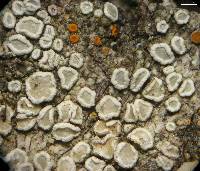
Consortium of Lichen Herbaria
- building a Global Consortium of Bryophytes and Lichens as keystones of cryptobiotic communities -
- Home
- Search
- Images
- Species Checklists
- US States: O-Z >
- US National Parks
- Central America
- South America
- US National Parks
- Southern Subpolar Region
|
|
|
|
Family: Lecanoraceae
[Lecanora juniperina Sliwa] |
Nash, T.H., Ryan, B.D., Gries, C., Bungartz, F., (eds.) 2004. Lichen Flora of the Greater Sonoran Desert Region. Vol 2. Thallus: granulose to areolate-rimose, grayish Apothecia: usually in groups, sessile, plane or flexuose when crowded, 0.3-1.2 mm in diameter disc: pale, sometimes yellow (often turning lead-colored), moderately to heavily pruinose (rarely epruinose), smooth margin: distinctly delimited, usually prominent, crenulate to dentate, epruinose or pruinose, paler than the disc amphithecium: thick, corticate, algae filling amphithecial medulla, with a continuous algal layer below the hypothecium; cortex: distinctly delimited, distinctly expanded at base (20-30 µm laterally, 60-70 µm basally), composed of adglutinated hyphae or gelatinous, cortical granules sparse or obscuring almost entire cortex area (pol+, insoluble in K, soluble in N); epipsamma absent or present (soluble in N) parathecium: distinct, thin (c. 10 µm) epihymenium: shades of yellow, granular (pol+), granules superficial and between paraphyses tips, fine, insoluble in K and insoluble in N hymenium: hyaline, 45-60 µm tall; paraphyses: slender, somewhat branched throughout, with few anastomoses, not expanded and usually not pigmented, coherent in K; subhymenium: indistinct, granulose; hypothecium: hyaline or almost so, composed of adglutinated hyphae, clear, without granules, 20-50 µm thick asci: clavate, 8-spored ascospores: hyaline, simple, ellipsoid, 8.9-13.3 x 4.5-5.9(-7.4) µm Pycnidia: not seen Spot tests: apothecial margin K-, C-, KC-, P-; disc K-, C-, KC-, P-; apothecia UV- Secondary metabolites: unknown xanthone(s) present. Substrate and ecology: on tree bark (Juniperus and Quercus) and wood, at intermediate elevations World and Sonoran distribution: Colorado Plateau area of northern Arizona. Notes: Although Lecanora juniperina is superficially similar to L. hagenii due to its distinctly pruinose apothecia and often dentate apothecia margins, it may be more closely related to L. dispersa due to its type of epihymenial granules (insoluble in K and N) and slender and branched paraphyses. Compared to the latter species, it differs, however, by having a more distinctive thallus and large, pale yellow pruinose apothecia with conspicuously crenulate margins. |
Powered by Symbiota































